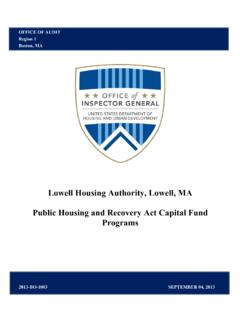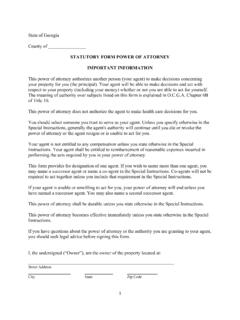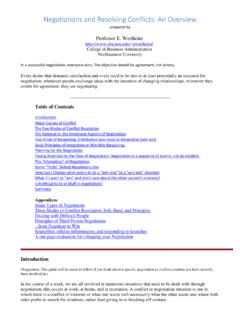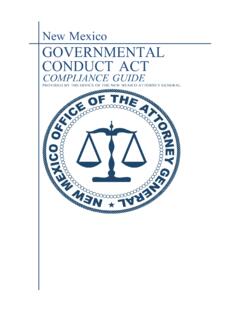Transcription of 7 Keys to Handling Conflicts of Interest
1 7 Keys to Handling Conflicts of Interest Conflicts of Interest arise when officials or staff stand to benefit--either directly themselves or indirectly through business partners or relatives--from the awarding or contracting of grant funds. Grantees are encouraged to avoid Conflicts of Interest to the extent possible. When Conflicts of Interest arise, grantees must identify, disclose, and manage them in compliance with applicable rules and regulations. When conflict-of- Interest issues are overlooked or hidden, this creates problems for the individuals involved, as well as grantees, subrecipients, or contractors. This bulletin discusses common types of Conflicts of Interest , offers best practices for avoiding and managing them, and the potential consequences of not Handling them appropriately.
2 1. Know the Requirements. In general, Conflicts of Interest occur when one s private Interest and public duties overlap, resulting in a real or perceived lack of independence or impartiality. Common situations include: Elected officials voting on awarding of funds to organizations where a family member is on the staff or where the elected official is on the subrecipient s board; Executive directors of subrecipients entering into contracts with companies they are affiliated through employment of, or ownership by, themselves or their relatives; Grantee officials or staff who have relatives who may benefit from a subrecipient s programmatic activities; and Failure to notify the Department of Housing and Urban Development (HUD) about Conflicts of Interest , or late and or incomplete requests for exceptions.
3 The existence of a conflict of Interest does not necessarily mean that any individual acted improperly or illegally, but it does mean that, unless properly handled and addressed, he or she could end up being in violation of Federal rules. Therefore, all such cases must be identified and resolved by eliminating the conflict or obtaining a written exception. Two sets of conflict-of- Interest rules exist one for procurement activities and others for non-procurement, sub-granting/program delivery activities. A. Procurement Standards: Regulations at 2 CFR (Code of Federal Regulations) (c) require non-Federal entities to maintain written standards of conduct Identify, disclose, and manage all real and apparent Conflicts of Interest through elimination, mitigation, or waivers.
4 Summer 2016 1 B. covering Conflicts of Interest , including organizational Conflicts of Interest . Organizational Conflicts of Interest occur when, because of relationships with a parent company, affiliate, or subsidiary organization, the non-Federal entity is unable or appears to be unable to be impartial in conducting a procurement action involving a related organization. Regulations are in transition between grants issued before December 26, 2014 (when 2 CFR Part 200 went into effect), and those issued later. See the footnote below for more Example of a Procurement Conflict of Interest A Neighborhood Stabilization Program (NSP) grantee funded a subrecipient to rehabilitate 28 homes. The subrecipient failed to report a conflict-of- Interest situation when it entered into two contracts with a construction company that was 50 percent owned by the NSP subrecipient s executive director.
5 Although the subrecipient stated that it had disclosed all relationships to the grantee in the proposal process, the grantee overlooked HUD's conflict-of- Interest requirements and the requirements found in the agreement. Because the grantee approved the proposal and awarded the agreement, the subrecipient believed that there were no conflict-of- Interest issues. The grantee should have flagged the conflict of Interest situation during its risk assessment of the subrecipient and prohibited the use of the executive director s construction firm. B. Non-procurement S tandards: Regulations at 2 CFR require HUD to establish conflict of Interest policies for Federal awards and require non-Federal entities to disclose in writing any potential conflict of Interest to HUD or a pass-through entity in accordance with HUD s policy.
6 HUD is finalizing its conflict-of- Interest policy, but entities are still expected to use the policies developed under the various Community Planning and Development (CPD) program-specific regulations. In general, all CPD program regulations prohibit grant-assisted activity benefitting relatives of people who work for the grantee or the pass-through entity. Example of Non-Procurement Conflict of Interest A city awarded a C ommunity Housing Development Organization (CHDO) $215,975 in HOME funds to sell and construct one single-family home. At the time of the award, a city official s daughter was the president of the CHDO. The city official abstained from voting on the basis that there was a relationship with the executive director. However, the city was required to disclose these relationships to HUD and had not done so.
7 The city should have developed and implemented written procedures to ensure compliance with HUD s conflict-of- Interest regulations, including disclosure of potential conflict-of- Interest situations. 1 For more detail see Special Directive SD-2015-01, dated February 26, 2015 Transition to 2 CFR Part 200, Uniform Administrative Requirements, Cost Principles, and Audit Requirements for Federal Awards, Final Guidance. ( ) 2 2. Train Employees Grantees and subrecipients ought to build an organizational culture that is conscious of potential Conflicts of Interest so that action can be taken to avoid or mitigate Conflicts as they arise. Provide conflict-of- Interest training for all employees, including those of the organization and the governing authority, the organization s leadership and, as appropriate, the organization s agents.
8 To have the most impact, the organization should have a written policy requiring annual conflict-of- Interest training, and legal counsel or other qualified individuals should review the policy with employees (and board members), subrecipient officers, and pass-through entity staff at least annually. Documenting training is a best practice. The organization should: Provide training; Require that staff annually submit certifications regarding outside businesses, outside employment, and volunteer positions; Record a certification of attendance at trainings; and Follow up with annual refresher sessions. 3. Create Procedures to Document Compliance Conflict-of- Interest policies and procedures should describe how Conflicts will be handled. When a conflict or potential conflict of Interest exists, the person with the conflict should advise the board or management committee in writing and seek guidance on how to resolve the conflict.
9 Conflict-of- Interest notifications usually include: The person s name, position, phone number and address; Details of the nature of the conflict of Interest , (perceived, apparent, or actual); Date of notification; and Requested action to address the conflict of Interest (recusal, exemption request, etc.). The notification and subsequent actions should be recorded in minutes of board or management meetings. Record-keeping best practices includes documenting: Conflict-of- Interest notifications; Cases of failure to disclose; Disclosure by others (for example colleague or member of the public); Reviews or investigations of alleged Assessment of the matter and how it was considered; Action taken or resolution; and Annoying or trivial claims. Conflicts ; 4.
10 Implement the Regulations Often people are unaware that their activities are in conflict with the best interests of the organization. A goal should be to raise awareness, encourage disclosure and discussion of issues that may constitute a conflict, and constantly encourage a culture of candor. 3 Leadership and culture are important aspects of compliance. Boards or leaders should establish a culture of compliance and honesty and encourage disclosure by establishing a protocol for staff to self-report possible Conflicts , raise suspected conflict-of- Interest issues, or ask for guidance, without fear of retaliation. Leadership should appoint an individual or office to ensure conflict-of- Interest rules are implemented and followed. However, the protocol should not rely solely on voluntary compliance, but also on procedures to allow grantees and subrecipients to report and have independent checks made to ensure that Conflicts do not exist.

















